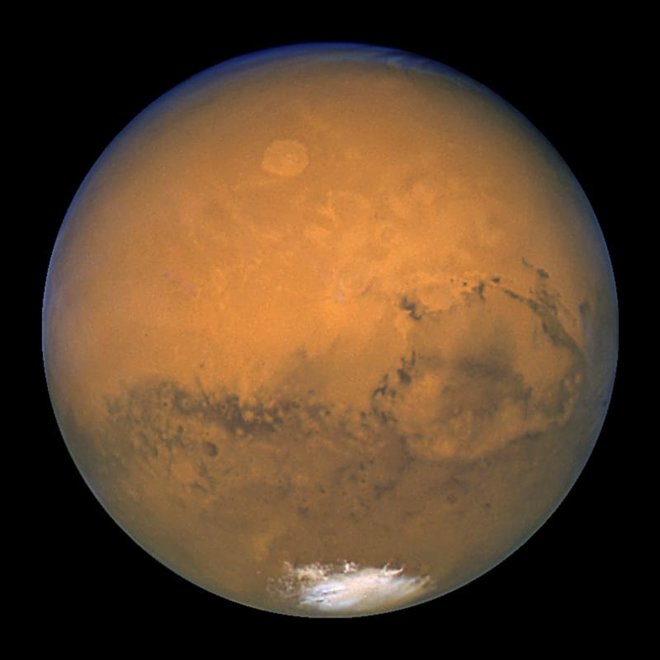Is the Great Pumpkin Rising? No, It’s Mars

“The most prominent feature is the southern polar cap, a tiny white dot on the south edge of Mars.“
Motorized combines and other harvest related vehicles and equipment have made their annual migration to Carroll County’s roads and fields, marking the start of agricultural autumn. The soybeans are being harvested now and field corn will soon follow. By the Halloween harvest festival at month’s end, children will be in colorful costumes and ornately carved Jack-o-lanterns will warmly glow due to candles burning inside.
Mars is a tricky target because, although it is bright and easy to view with the unaided eye, its apparent size is rather small making telescopic observations of its surface features difficult. So, let us start by talking about its naked eye appearance.
I’ve been glimpsing Mars naked eye in the east for the past couple of months around the midnight hour and it has been rising earlier every night. Barring obstruction from trees, hills or buildings, Mars appears as a brilliant orangish-red “star” impossible to miss and is currently outshining even Jupiter.
Jupiter and slightly fainter Saturn to its immediate left are up together in the south at 8 p.m. local time. At that time, Mars has just risen and is floating low in the east. As the evening progresses, Mars continues rising.
“Opposition” occurs when an outer planet, like Mars, is opposite from the sun, as viewed from Earth. Opposition is the time normally when a planet is closest to Earth and best placed for viewing because fine details will be clearer. Any planet at opposition is best placed – i.e. highest – in the sky at local midnight. Be aware, local midnight occurs at 1 a.m. when on Daylight Time because the clocks have been “sprung forward.”
However, Mars has a notoriously elliptical or, as astronomers would say, “eccentric” orbit about the sun. Because of this eccentricity, the planet is closer to us at some oppositions than others. The closest oppositions always happen in summertime when Mars is unfortunately low in the murky sky for us in the northern hemisphere.
The current opposition is not one of the very closest, but it does occur when Mars is riding high in the sky thus allowing for sharper views as telescopes aimed high are peering through less atmosphere and haze. It is considered to be a compromise opposition. Even so, it is the best opposition until the year 2035, according to Sky & Telescope magazine.
A planet at opposition is typically at its closest to Earth. Mars will reach the point of opposition on Tuesday, October 13. However, due to the orbital eccentricity, Mars’ closest approach to Earth actually happens one week earlier on October 6. The difference is about 410,000 miles.
Telescopically, the apparent size of the disk of Mars is a little more than half as large as Jupiter. Significant magnification of 200x to 400x is needed to detect and identify surface markings. Also, a moderate telescope with an 6”, 8” diameter or larger aperture is needed to collect enough light to create an image bright enough for the eyepiece to magnify without appearing faint or fuzzy. (These are my opinions based on experience.)
Also important is a sturdy mount to keep the image in view. A clock driven Equatorial mounting is preferred if available. Otherwise, at high magnification, the need to constantly adjust the telescope manually to compensate for the earth’s rotation can be troublesome as it is easy to bump the image out of view requiring the observer to reacquire and recenter the target, only to have it drift out of the field due to the rotation of the Earth, again.
The most prominent feature is the southern polar cap, a tiny white dot on the south edge of Mars. Although it is currently summer in the Martian southern hemisphere and the cap is shrinking, it should still be visible.
What you will see can depend on your telescope, eyepieces, atmosphere, experience and patience. The best place to start would be any online service that will give you a real time simulation of the Mars hemisphere facing earth.
A good place to start is with the “Mars Profiler” at SkyandTelescope.org, an application showing the current Mars hemisphere facing earth with the features labeled.
The profiler can be customized to even give the view through different telescopes – i.e. “inverted” or “mirror reversed.” Time is given in Universal Time (UTC). Eastern Daylight Time is UTC-4.
One interesting fact about Mars is that its day is 37 minutes longer than an Earth day. Thus, at any given time from night to night, the face of Mars changes only slightly. During a nightly observing session, Mars slowly rotates bringing new features into view.
Mars should remain well suited for viewing for at least another month. Good luck viewing Mars this Fall. Whether you use your unaided eye or the telescope, have fun viewing the next neighbor out from the sun.
–Curt Roelle
